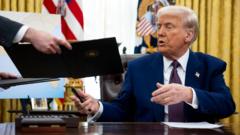A recent decision by a US appeals court has declared a significant portion of tariffs implemented by the Trump administration to be unlawful, immediately raising questions about the next steps and broader implications. This ruling targets specific applications of executive authority used to impose these trade barriers, rather than challenging the concept of tariffs outright.
The immediate aftermath creates a complex situation for businesses, importers, and the government. A central question is whether the tariffs deemed illegal will be automatically rescinded or modified, and what that means for goods currently in transit or those that have already cleared customs.
The current US administration now faces several options. It could choose to appeal the decision to a higher judicial body, potentially the Supreme Court, seeking a reversal of the appeals court’s judgment. Alternatively, the administration might decide to comply with the ruling, which would necessitate adjustments or the complete removal of the tariffs in question.
Compliance carries substantial financial implications. It could lead to a wave of demands for refunds of duties already paid by importers on affected goods. The total value of such potential refunds could amount to billions of dollars, presenting a significant logistical and financial challenge for government agencies like the Treasury Department and Customs and Border Protection.
Businesses that have structured their supply chains, pricing, and market access strategies around the existence of these tariffs will now need to rapidly reassess their operations. A rollback of tariffs could alter competitive landscapes, open new import avenues, and potentially impact consumer prices for a range of products.
Beyond the immediate financial and operational considerations, the ruling also prompts a re-evaluation of the scope of presidential authority in trade policy. It could set precedents that influence how future administrations approach the imposition of trade protectionist measures. The ultimate resolution will depend on the executive branch’s strategic decision regarding further legal challenges or compliance, alongside any subsequent legislative or regulatory adjustments. This evolving scenario is expected to remain a focal point for international trade experts, legal professionals, and the business community as the full implications become clear.



